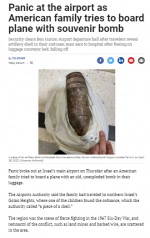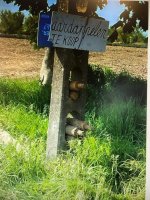You are using an out of date browser. It may not display this or other websites correctly.
You should upgrade or use an alternative browser.
You should upgrade or use an alternative browser.
Candidates for Darwin Awards?
- Thread starter 911car
- Start date
Khukri
Well-known member
In the Ypres region in Flanders/Belgium farmers stock their Iron Harvest this way. Alongside the roads. A bit higher, above the grass. (The board says "Patatoes for sale"). The location is often marked with a plastic bag. Not hidden. (These are Stokes I think)...Local Police is notified. On their turn they give the info to the Belgian Army EOD unit. These teams tour the former battlefields every day. That does not mean they come and collect the same day...Sometimes the realy-realy dangerous stuff is blown up near the spot. The rest is carefully put in a flat box filled with sand-preventing the lot rolling around in the truck. Then carefully registered and stocked untill the day has come they are collected in a large crate, lowered by crane in a deep pit, together with a charge and detonator, pit filled with heavy clay. Then at noon sharp. The siren is sound to notify the neighbouring civilians. BOOM. Chemical shells are dismantled, one by one, in a special installation at the Barracks Depot ground. They estimate it'll take another century to clean up the UXO that surfaces or is found during road- or other constructionworks. One can understand that some people might be tempted to pick up a "souvenir"...
Attachments
Last edited:
coert65
Well-known member
Excatly. I visit the region around Ypres for about 25 years now. Unexploded ordnance can be found very easily there. Still, even to this day accidents happen with these.. I never touch them, taking them home with me is really a no-go. The ones on your picture are indeed Stokes mortar bombs.In the Ypres region in Flanders/Belgium farmers stock their Iron Harvest this way. Alongside the roads. A bit higher, above the grass. (The board says "Patatoes for sale"). The location is often marked with a plastic bag. Not hidden. (These are Stokes I think)...Local Police is notified. On their turn they give the info to the Belgian Army EOD unit. These teams tour the former battlefields every day. That does not mean they come and collect the same day...Sometimes the realy-realy dangerous stuff is blown up near the spot. The rest is carefully put in a flat box filled with sand-preventing the lot rolling around in the truck. Then carefully registered and stocked untill the day has come they are collected in a large crate, lowered by crane in a deep pit, together with a charge and detonator, pit filled with heavy clay. Then at noon sharp. The siren is sound to notify the neighbouring civilians. BOOM. Chemical shells are dismantled, one by one, in a special installation at the Barracks Depot ground. They estimate it'll take another century to clean up the UXO that surfaces or is found during road- or other constructionworks. One can understand that some people might be tempted to pick up a "souvenir"...
Some people just do not realize, that these grenades and bombs were made to kill. And they still have that capacity if handled wrong.
Khukri
Well-known member
So true, hands off. Every now and then a "collector" blows himself skyhigh whilst cleaning the latest find. More often UXO is detonating beneath the plow or in a harvester. After more then a century the thinner mantles of chemical shells might easily set free their agent. -Mustard"gas" (which is not a gas)...It's a sticky liquid. You don't want that on your skin...Secundary danger of the Blistering Agent: evaporation. You get it in the eyes and enhale it. Blistering of the airways, the lungs... -You go for patatoes at a farm you better check twice as a handgranade-encrusted with clay-looks exactly the same... Bon apetit!Excatly. I visit the region around Ypres for about 25 years now. Unexploded ordnance can be found very easily there. Still, even to this day accidents happen with these.. I never touch them, taking them home with me is really a no-go. The ones on your picture are indeed Stokes mortar bombs.
Some people just do not realize, that these grenades and bombs were made to kill. And they still have that capacity if handled wrong.
coert65
Well-known member
Thanks for your service! I saw so many UXO's there.. they seem to keep getting out of the ground. Many shells were fired there, and, because of the muddy grounds there, many did not explode. Last year, I saw a pile of long 77mm shells, with the zinc LKZ17 zunder on them. Most, if not all, were musterd gas shells. With the small bottle inside them, containing the liquid substance.. I was there with a friend, he asked me if they were still dangerous. When I told him what shells they probably were, he lost all interest in them, off-course. Not that he wanted to take one home, he just didn't know the danger those shells still represent.-Organised many training for our Manpad teams in that region.
-Important point in the briefing: UXO.
I used to show my students a documentary video on the “Belgian Bomb Squad”, which showed them retrieving and eventually blowing up this ordinance. There was also a visit to a potato processing plant to deal with a Mills bomb which had been gathered up with the harvest!  The Ukrainians are already having to deal with booby traps and mines left behind by the Russians.
The Ukrainians are already having to deal with booby traps and mines left behind by the Russians.



